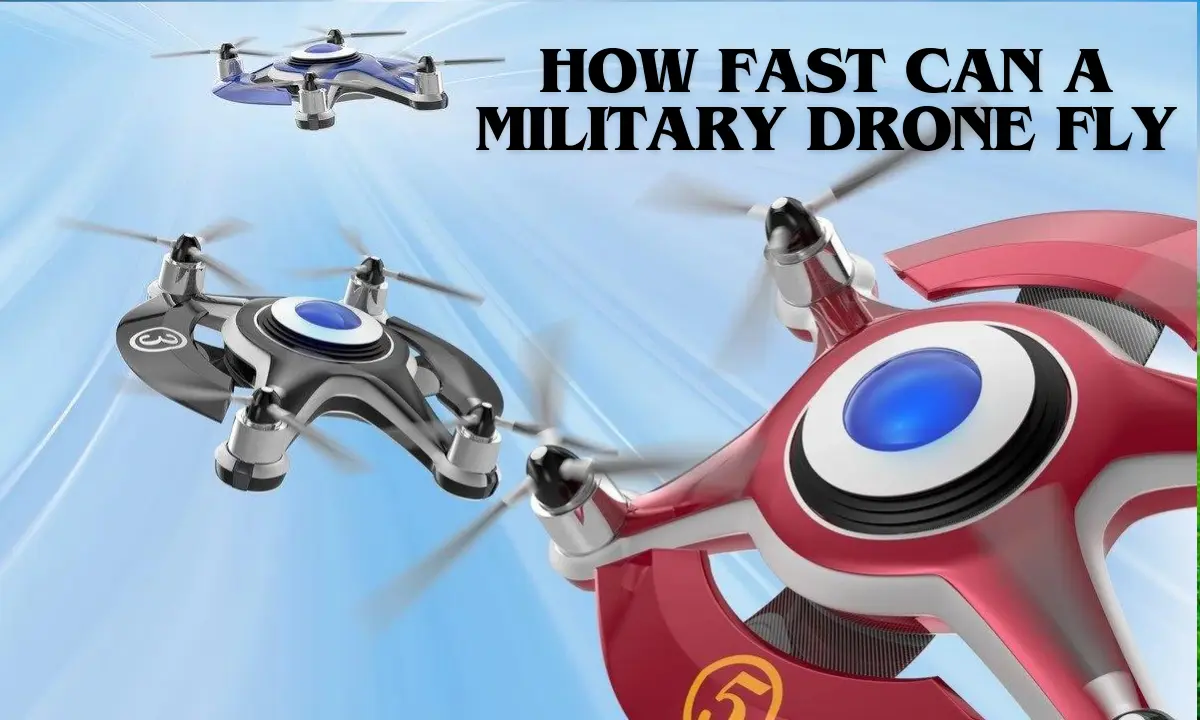How fast can a military drone fly: Military drones have revolutionized the modern battlefield, offering advanced capabilities in surveillance, reconnaissance, and combat operations. These unmanned aerial vehicles (UAVs) have come a long way from their early reconnaissance days to the sophisticated and lethal machines they are today. One crucial aspect that defines the effectiveness of a military drone is its speed. In this article, I will explore the fascinating world of military drone speeds, from their evolution to their potential future.
What is a Military Drone?
Before diving into the specifics of their speed, let’s understand what military drones are. A military drone, also known as an unmanned combat aerial vehicle (UCAV), is an aircraft that operates without a human pilot onboard. These drones can be remotely controlled or operate autonomously using pre-programmed instructions. They have proven to be invaluable assets for armed forces worldwide due to their versatility and unique capabilities.
The Evolution of Military Drones
Early Reconnaissance Drones
The concept of using unmanned aircraft for military purposes dates back to the early 20th century. During World War I, both the British and the U.S. military experimented with radio-controlled aircraft for surveillance missions. These early reconnaissance drones laid the groundwork for future advancements in drone technology.
Advancements in Drone Technology
In the following decades, significant strides were made in drone development. The introduction of jet engines, improved materials, and better data transmission systems allowed for more extended flight ranges and higher speeds. By the late 20th century, military drones had evolved into critical assets for intelligence gathering and surveillance missions.
Modern Combat Drones
With advancements in technology, military drones transitioned from being purely reconnaissance tools to lethal combat machines. Today’s modern combat drones can carry out targeted strikes, engage enemy targets, and gather intelligence in real-time. These advancements have been instrumental in reshaping military strategies and tactics.
Speed and Performance of Military Drones
Factors Affecting Speed
The speed of a military drone depends on several factors, including its design, propulsion system, weight, and intended purpose. Generally, smaller reconnaissance drones have lower speeds, while combat drones are designed for greater speed and maneuverability.
High-Speed Military Drones
Some of the most advanced military drones can achieve astonishing speeds. Some of the fastest drones can reach speeds of over Mach 3 (three times the speed of sound). These high-speed drones are capable of executing rapid strikes and evading enemy defenses effectively.
Speed vs. Endurance
While speed is crucial for certain missions, such as intercepting enemy aircraft or conducting swift strikes, it often comes at the cost of endurance. High-speed drones may have limited flight times due to increased fuel consumption and higher stress on the aircraft. On the other hand, drones designed for long-endurance missions may sacrifice some speed to conserve energy and increase flight time.
Use Cases of Fast Military Drones
Surveillance and Reconnaissance
Fast military drones play a vital role in surveillance and reconnaissance missions. Their ability to cover large distances quickly allows them to gather valuable intelligence in real-time. They can monitor enemy movements, identify potential threats, and provide critical data to ground forces.
Target Acquisition and Elimination
When it comes to target acquisition and elimination, speed can be a decisive factor. Fast military drones can swiftly identify and engage high-value targets, making them indispensable assets for precision strikes.
Combat and Air Superiority
In combat scenarios, speed is often the key to gaining air superiority. High-speed military drones can engage enemy aircraft, intercept incoming threats, and support manned fighter jets in their missions.
Challenges and Limitations
Technical Challenges
Developing and maintaining high-speed military drones pose significant technical challenges. Engineers must carefully balance the aircraft’s weight, aerodynamics, and propulsion systems to achieve both speed and stability.
Regulatory and Ethical Concerns
The use of military drones, especially those capable of high speeds and lethal capabilities, raises ethical questions. Concerns over civilian casualties, privacy violations, and potential misuse have prompted strict regulations and international debates.
Future of Military Drones
Hypersonic Drones
The future of military drones lies in hypersonic technologies. Hypersonic drones, traveling at speeds greater than Mach 5, could redefine aerial warfare, offering unprecedented speed and agility.
Artificial Intelligence Integration
Artificial intelligence (AI) integration will further enhance military drone capabilities. AI-powered drones could autonomously analyze data, adapt to dynamic situations, and make split-second decisions on the battlefield.
FAQs
Are military drones faster than manned aircraft?
Military drones designed for speed can sometimes outpace certain manned aircraft, especially those optimized for specific missions.
How fast can the fastest military drone travel?
The fastest military drones can reach speeds of over Mach 3, which is more than 2,300 miles per hour.
Do high-speed military drones sacrifice flight time?
Yes, high-speed drones often have reduced flight times compared to slower, long-endurance drones due to increased fuel consumption.
What are the primary applications of fast military drones?
Fast military drones are primarily used for surveillance, reconnaissance, target acquisition, combat, and air superiority missions.
What challenges do hypersonic drones pose?
Hypersonic drones present significant technical challenges, such as heat management and aerodynamic stability, due to their extreme speeds.
Conclusion
In conclusion, the speed of military drones plays a vital role in their effectiveness and versatility on the modern battlefield. From their humble beginnings as reconnaissance tools to their current state as lethal combat machines, military drones continue to push the boundaries of technology and redefine the nature of warfare. As advancements continue and ethical considerations are addressed, the future of military drones holds promise for even greater speed, precision, and impact. However, if you have any questions or queries regarding drones, feel free to ask in the comment section without any hesitation. Thank you for reading!
Read more: How drones can be used in agriculture

